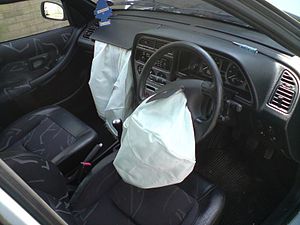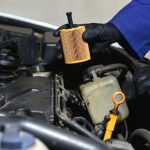A vehicle airbag, according to Wikipedia, is a vehicle occupant-restraint system using a bag designed to inflate extremely quickly, then quickly deflate during a collision. It is a safety component of a vehicle which consists of the airbag cushion, a flexible fabric bag, an inflation module, and an impact sensor.
Airbags are purposely made to keep vehicle occupants safe with soft cushioning and restraints, during a collision. It can reduce injuries between the flailing occupant and the interior of the vehicle.
During auto crashes, the vehicle’s crash sensors provide crucial information to the airbag electronic controller unit (ECU), including collision type, angle, and severity of impact. Using this information, the airbag ECU’s crash algorithm determines if the crash event meets the criteria for deployment and triggers various firing circuits to deploy one or more airbag modules within the vehicle, while also working as a supplemental restraint system to the vehicle’s seat-belt systems, airbag module deployments are triggered through a pyrotechnic process that is designed to be used once.
Why front and side airbags?

In a bid to optimally ensure safety of vehicle occupants during crashes, Frontal airbags have been required in all new passenger vehicles since the 1999 model year, Side airbags on the other hand, aren’t specifically mandated but nearly all manufacturers include them as standard equipment to meet the USA’s federal side protection requirements.
Front airbags are designed to inflate in moderate to severe frontal crashes to prevent a person’s head and chest from contacting hard structures in the vehicle. They offer the most protection when occupants are wearing safety belts and sitting properly in the seat but are designed to provide protection for all occupants.

Typically, front airbags will deploy for unbelted occupants when the crash is the equivalent of an impact into a rigid wall at 10-12 mph. Most airbags will deploy at a higher threshold of about 16 mph, for belted occupants because the belts alone are likely to provide adequate protection up to these moderate speeds.
Front airbags may deploy to help protect occupants in side impacts if there is sufficient forward movement during the crash.
The driver’s airbag is in the steering wheel while that of the passenger is in the dashboard. Also, some manufacturers provide supplemental knee airbags, located a little bit below the dashboard, which are intended to distribute impact forces to reduce leg injuries during crashes. They may also help reduce forces on an occupant’s chest and abdomen by controlling movement of the occupant’s lower body.

However, Head- and chest-protecting side airbags are designed to inflate in side crashes to prevent people’s heads and chests from contacting intruding parts of vehicle side structure, a striking vehicle, or an object such as a tree or pole. Side airbags cushion and spread the load of impacts to prevent any part of the body from sustaining concentrated impact forces.
Due to the small space between an occupant and the side of the vehicle, side airbags must deploy very quickly, typically within the first 10-20 milliseconds of a side crash. Deployment thresholds can be as low as 8 mph for narrow object crashes (e.g., trees and poles) and 18 mph for the more widely distributed side impacts (vehicle-to-vehicle crashes). Side airbags also deploy in certain types of frontal crashes.

Airbag injuries
From various studies conducted by experts in the auto manufacturing industry, it was discovered that sometimes, the energy required to quickly inflate airbags can cause injury to people sitting or thrown too close to the airbag before it deploys, which was a serious concern with the first generations of frontal airbags, which deployed with greater force.
The National Centre for Statistics and Analysis, (NHTSA) in its 2017 study, (as quoted in an article on iihs.org) posited that during 1990-2008, more than 290 deaths were caused by frontal airbag inflation in low-speed crashes (National Center for Statistics and Analysis, 2017). Nearly 90 percent of the deaths occurred in vehicles manufactured before 1998, and more than 80 percent of people killed were unbelted or improperly restrained. Most of the deaths were passengers, and more than 90 percent of those were children and infants, most of whom were unbelted or in rear-facing child safety seats that placed their heads close to the deploying airbag. Short and elderly drivers, who tend to sit close to the steering wheel, also were vulnerable to inflation injuries from frontal airbags.
Side airbags can also deploy with enough energy to cause injury, although they typically are smaller and deploy with less energy than frontal airbags.

How to prevent injuries from airbags?
As it has been established by several studies that airbags can cause injuries to vehicle occupants, here are some useful tips to prevent such injuries
- Drivers and front-seat passengers should sit in the center of the seat upright against the seatback with feet on the floor.
- Arms and legs should not be resting against an airbag because the forces of a deploying airbag and the hot gases exhausted by the airbag may cause injury.
- Drivers should sit with their chests at least 10 inches away from the center of the steering wheel. Shorter drivers who need the seat positioned further forward can often achieve this by slightly reclining the seat back.
- Young children should sit in the rear seat. If a child does need to ride in the front seat, the seat should be as far back as possible, and the child should be securely buckled in a lap/shoulder belt and sitting against the seatback.
- Children shouldn’t lean against the door area where the side airbag is stored because the initial deployment force may be harmful.
- For women in the late stages of pregnancy, a combination of properly positioned safety belts and airbags offers the best protection.
Conclusively, Airbags don’t typically require maintenance unless they are deployed in a crash, hence, they must be replaced at a competent repair shop that uses original equipment manufacturer (OEM) replacement parts to ensure that the new airbag is not counterfeit. Counterfeit airbags may fail to deploy or release metal shrapnel during deployment. Fixit45 offers quality and comfortable vehicle repair and maintenance with its network of workshops around the country. Also, its sub brand XPARTS ensures OEM are gotten, to facilitate repairs and keep vehicles in best conditions possible.






